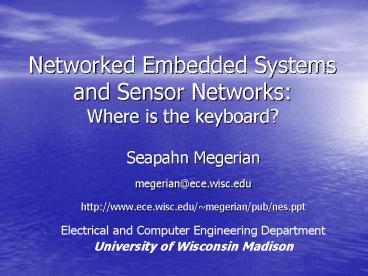Networked Embedded Systems and Sensor Networks: Where is the keyboard - PowerPoint PPT Presentation
1 / 17
Title:
Networked Embedded Systems and Sensor Networks: Where is the keyboard
Description:
Networked Embedded Systems and Sensor Networks: Where is the ... COTS Dust - RF Mote. Crossbow - Mote. CCR Mote. Sensoria sGate 'Sensor Network' as a System ... – PowerPoint PPT presentation
Number of Views:945
Avg rating:3.0/5.0
Title: Networked Embedded Systems and Sensor Networks: Where is the keyboard
1
Networked Embedded Systems and Sensor
NetworksWhere is the keyboard?
- Seapahn Megerian
- megerian_at_ece.wisc.edu
- http//www.ece.wisc.edu/megerian/pub/nes.ppt
- Electrical and Computer Engineering Department
- University of Wisconsin Madison
2
Outline
- Introduce networked embedded systems
- Motivate potential applications
- What is new?
- Examples of active research projects
- Autonomous calibration
- Sensor coverage and deployment
- Environment control
- Future directions and Summary
3
Networked Embedded Sensor Networks
- Environment monitoring
- Weather, contaminants, earthquake, fire, habitats
- Surveillance, security, disaster relief
- Traffic safety
- Smart spaces
- Home and office automation
- Ubiquitous and proactive computing
4
Platform Examples
- COTS Dust - RF Mote
Crossbow - Mote
CCR Mote
Sensoria sGate
5
Sensor Network as a System
- Deployment Where do we put the sensors?
- Engineered
- Ad Hoc
- Operation How will the system function?
- Initialization, discovery
- Self assembly and communication
- Management
- Sensing and Computing
- Must deal with uncertainties and errors
autonomously - Security and Privacy
6
Differences from Wireless Networking
- Wireless data networks (e.g. 802.11b)
- Goal is to transmit data from one end point to
the next - Networked Embedded Sensor Systems
- Tasks vary
- Point to point data transmission often not the
goal - Data processed in the network
- Each node may potentially have great processing
power - Self organizing
- Some similarities to ad-hoc networking
- Autonomous and at times inaccessible nodes.
7
Networked Sensor Systems
- Primary Goal is Sensing
8
The Errors Will Be There
- Measurement errors
- Calibration
- Noise
- Parameter errors
- Locations
- Orientations
- Modeling Errors
- Solution Errors
9
Calibration How to Deal with Space and Time?
d2
d1
S1
S2
Source
M0
M1
M2
- We want to know value of M0
- We know S1, S2, d1, and d2
- M1 and M2 are functions of S1 and S2
- Example Mi Si ?i
- Need relation between M1 and M2 to solve for
- M0, ?1, and ?2
10
Sensor Deployment and Coverage
- How well do the sensors observe the world?
11
0/1 Coverage An Example
12
0/1 Min Cover A Random Instance
Random Instance 200 Sensors
Min Cover 16 Sensors
13
Sensor Exposure
Minimal exposure path for 50 randomly deployed
sensors
14
Light Sensing Demonstration
15
Summary Sensor Network Challenges
- Power constraints absolutely crucial
- Limit communication as processing is cheap
- Self organization
- Autonomous operation
- Design and deployment
- Enabling technologies
- Software radios
- Smart antennas
- Miniaturization
- MEMs
16
Other Current Research Projects
- Sensor calibration in distributed settings
- Error analysis
- Impacts of parameter errors on applications
- Example Location errors and coverage
- Localized algorithms
- Efficient design space exploration
- Embedded systems
- Architectures
- Algorithms
17
Networked Embedded Systems and Sensor
NetworksWhere is the keyboard?
- Seapahn Megerian
- megerian_at_ece.wisc.edu
- http//www.ece.wisc.edu/megerian/pub/nes.ppt
- Electrical and Computer Engineering Department
- University of Wisconsin Madison

